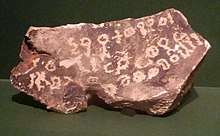Thamudic
Thamudic is a name invented by nineteenth-century scholars for large numbers of inscriptions in Ancient North Arabian (ANA) alphabets which have not yet been properly studied. It does not imply that they were carved by members of the ancient tribe of Thamud. These texts are found over a huge area from southern Syria to Yemen. In 1937, Fred V. Winnett divided those known at the time into five rough categories A, B, C, D, E. In 1951, some 9000 more inscriptions were recorded in south-west Saudi Arabia which have been given the name Southern Thamudic.[1]


Thamudic A is now known as Taymanitic. Thamudic E is now known as Hismaic. Southern Thamudic is also known as Thamudic F.
Varieties
Thamudic B
The Thamudic B inscriptions are concentrated in Northwest Arabia, but can be occasionally found in Syria, Egypt, and Yemen.[2]
Thamudic C
The Thamudic C inscriptions are concentrated in the Najd, but can be found elsewhere across western Arabia as well.[2]
Thamudic D
Thamudic D inscriptions are concentrated in northwest Arabia, and one occurs alongside a Nabataean tomb inscription in Hegra (Mada'in Salih) dated to the year 267 CE.[2]
Thamudic F (Southern Thamudic)
Thamudic F texts come from the southwestern part of the Arabian Peninsula and seem to contain only names, although some of these names contain mimation and one example of a hl- */hal/ definite article.[2]
References
- dan. "The Online Corpus of the Inscriptions of Ancient North Arabia - Home". krc.orient.ox.ac.uk. Retrieved 2016-07-15.
- "Al-Jallad. The earliest stages of Arabic and its linguistic classification (Routledge Handbook of Arabic Linguistics, forthcoming)". Retrieved 2016-07-15.
- Lipinski, Edward (2001). Semitic Languages: Outlines of a Comparative Grammar (2nd ed.). Leuven: Orientalia Lovanensia Analecta. p. 75.